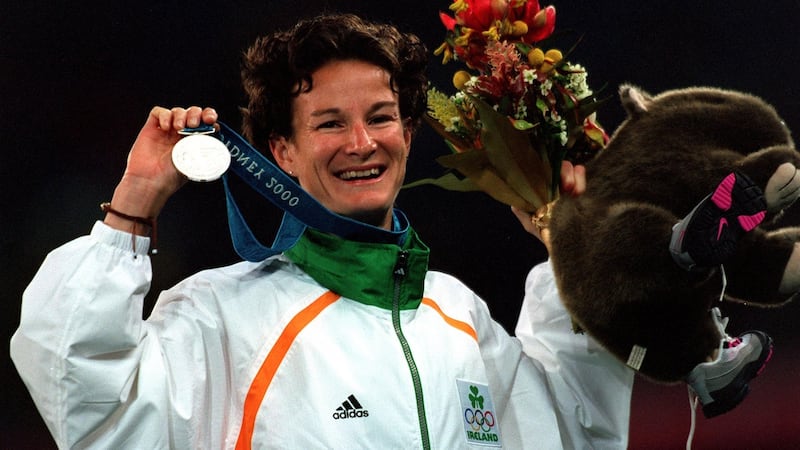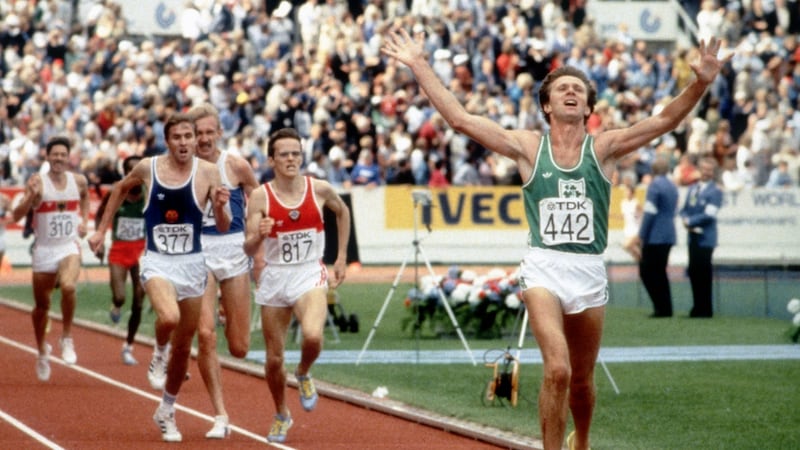“Are you John Joe Barry?” he was asked, after answering the phone at some ungodly hour at his apartment in suburban Philadelphia.
“I am,” he replied, half-wondering what trouble he was in this time.
“And were you ever known as The Ballincurry Hare?”
“Now look here Buster,” he said. “I’m already late for work and I’m halfway out the door and if this is some kind of joke your timing is away off.”
Just before slamming down the phone, he was somehow convinced the man at the other end of the line was from RTÉ, in Dublin, and that someone had told him he was indeed dead. “Look, call me in my office in 20 minutes, and I’ll do my level best to prove to you that I’m alive . . . ”
One small tale in Irish athletics history, and still part of the one giant leap in the history of Irish athletics: the man was indeed named John Joe Barry, was definitely still alive back then, and one of the original trio of Irish athletes who first took up an American scholarship, along with sprinter Jimmy Reardon and discus thrower Cummin Clancy, in the aftermath of the 1948 Olympics in London.
Their story has been touched on many times, and yet over 70 years later some of the many others who followed in their blazing footsteps were never heard of again, dead or alive. Not because their athletic or lifetime ambitions went unfulfilled, but simply because there was no even rough record of them.
Until now: Irish athletics historian Pierce O’Callaghan has pieced together the first definitive list of Irish athletes who went on American scholarships, men and women, across almost all 50 states, since 1948. There’s 715 in all, including the majority of Irish championship medal winners, a wall of American collegiate champions, some brothers and sisters, and the first father and son.
Barry’s own story is one of those you couldn’t make up and features late on in his self-penned autobiography The Ballincurry Hare. It was sometime in early 1976, and Barry, once the most exciting middle-distance runner in Ireland, was working in an auto dealership, in east Philadelphia. As it turned out the man at the other end of the phone line was Fred Cogley, one of RTÉ’s main sports presenters. He’d tracked Barry down, four days after every newspaper in Ireland had written up glowing obituaries.
What happened was that previous Sunday, at noon mass in his old parish of The Commons, Tipperary, a prayer was read for the recently deceased JJ Barry. Someone got confused somewhere along the line, and on the Monday, one Dublin evening newspaper declared Barry – who by then had lost virtually all contact with Ireland – as dead. By the Tuesday, all the dailies followed suit.

“It was now the Friday,” Barry wrote of Cogley’s phone call, “and I eventually convinced him that I was who he thought I was and that I was actually talking on the telephone and that I could not be possibly dead.”
Cogley was so taken by the tale that he arranged to fly out to America, the next day, to interview Barry for RTÉ. On arrival, he presented Barry with a “roll of newspapers that would choke an elephant, all of which had given me one hell of a send-off”. Indeed Barry lived on for many years, eventually returning to Dublin, where he died in December 1994.
Barry also recalls the details of the first American scholarship deal in his book, how the three of them were in London for those 1948 Olympics, and while himself and Reardon may have sparked the idea, it was Clancy who perhaps sealed the deal.
“George Guida, a member of the USA 440 squad and a student at Villanova, Reardon and myself were talking one evening after a snack in the dining hall, and the conversation led into the meaning of an athletic scholarship in American universities. It was Reardon who put the question to him: ‘George, you’re telling me if you could run or jump well enough, you’d get a scholarship to an American university, which would include full tuition, full board, books, etc?’
“‘In my opinion,’ George continued, ‘both of you would easily qualify, from what I know, and from what you told me about yourselves. The very fact that you are both here representing your country, you must be the best Ireland has to offer at this moment. Villanova is very short of middle-distance runners at the moment, and nothing would go down better than to have a few Irish boys on the squad.’
“Just then Cummin Clancy, the discus-thrower, came over. Cummin was a magnificent specimen: 6’2” in height, 46-inch chest, 32-inch waist and as good looking as Jack Doyle.
“Jimmy asked George, ‘How about Cummin here?’
“George took one look at Cummin [he already knew a little about him] and said, ‘Why, Jumbo Elliott would make him into a world-beater’”.
Jumbo didn’t quite succeed with Clancy, who did however win the American Collegiate Championship with a throw of 172 feet – no mean feat. Clancy, originally from the village of Glann, near Oughterard in Galway, lived to the ripe old age of 90, and died at his adopted home in Garden City, New York, in February 2013.
Reardon died last June at the age 93, and the passing of that original trio further inspired O'Callaghan to begin piecing together the definitive list, with the assistance of Killian Lonergan at Athletics Ireland, who also went on the American scholarship trail to Harvard University.

“This is a most fascinating part of Irish athletics history,” says O’Callaghan, “because when the first athletes went Stateside in the late 40s and 50s, Irish athletics was deeply divided with two organisations, the NACA and AAUE, holding separate championships and events which greatly hindered the development of the sport in Ireland for decades.
"The US scholarship system exposed the likes Ronnie Delany, Noel Carroll, Eamonn Coghlan and John Treacy to world-class coaching and competition, which was key in their development as future international superstars and household names. They were followed by Frank O'Mara, Marcus O'Sullivan, Sonia O'Sullivan, all of whom used the American scholarship system as the launching pad which would eventually propel them to winning world titles.
“Of course, it did not work for every athlete, and that was inevitable with over 700 athletes who availed of the system, but many who didn’t fulfil their dreams on the track went on to find success in the business and coaching world. As a sport and a nation we should all be immensely proud of their successes. The 700 names deserve to be recorded for historical purposes, and for the many who left small rural schools and towns around Ireland with a sense of adventure and ambition, to this day, with 30 athletes currently on scholarship.”
The Pipeline, as the American scholarship trail was originally known, soon spread far beyond Villanova University, the small rural-like campus 12 miles northwest of Philadelphia. Villanova, however, is where the connection still runs strongest: Delany came soon after 1948 and won the Olympic 1,500 metres in 1956 during his second year at Villanova.
Since then there's been Noel Carroll and Frank Murphy in the 1960s; Donie Walsh, John Hartnett and Coghlan in the 1970s; into the 1980s with Marcus O'Sullivan, Gerry O'Reilly and Olive Burke, the Limerick sprint hurdler who in 1984 became the first Irish woman to take up an American scholarship at Villanova, and three years later, she was joined by Sonia O'Sullivan. Charlie O'Donovan, the promising distance runner from Cork, is currently enrolled at Villanova, running a sub-four minute mile indoors in January, ensuring that link continues into the 2020s.
The Pipeline soon spread along the east coast, from Providence College in Providence, Rhode Island, to Iona in upstate New York, south to Arkansas and East Tennessee, north to Michigan and Notre Dame, west to California and as far northwest as Pocatello, Idaho, in the heart of the Rockies. I know that because my dad still tells the story about the day he got a letter from Idaho State University in 1957 offering him a scholarship. All he needed to do was get himself to Pocatello and they'd take care of everything else from there; over 30 years later the first father and son scholarship run was completed in 1990 when this correspondent packed his bags for Brown University in Providence, Rhode Island.
For many years the American scholarship trail was signposted as the only way for Irish athletes to succeed in the sport. The dearth of facilities and proper competition at home meant those who dared stay behind were almost destined to fail. When Treacy won his two World Cross-Country titles, in 1978 and 1979, he was still on scholarship at Providence College; same with O’Sullivan, who burst onto the Olympic stage in Barcelona in 1992 while still on scholarship at Villanova.
Throughout the now 72 years there has always been some debate about the pros and cons of the American scholarship, and plenty of Irish championship medal winners and record holders were proven perfectly right to develop their distance running talents at home, including Catherina McKiernan, David Matthews, James Nolan, Fionnuala McCormack and more recently Mark English.
For some, however, there might not have been any running career without an American scholarship: Noel Carroll went on to compete in two Olympics over 800m, in Tokyo 1964 and Mexico City 1968, one of the dominant runners of his time. When Villanova’s famous coach Jumbo Elliott first saw how fluently Carroll moved around the old Madison Square Garden he offered him a scholarship on the spot. When he beat the Canadian Bill Crothers, who won 800m silver in Tokyo, Sports Illustrated described Carroll as “one of the best middle-distance runners in the world”, which he was, before his sudden death in October 1998.
Others are gone too but should not be forgotten, their names now on the A-Z list, or at least A-Y, beginning with Geraldine Acheson, who went to Oklahoma via Dublin City Harriers, to Richie Yeates, who went to Providence via Raheny Shamrock, each one with their own small tale i n Irish athletics history.
Championship medals won by Irish scholarship athletes
Olympics
1956: Ronnie Delany (Villanova), 1,500m gold, Melbourne
1984: John Treacy (Providence), marathon silver, Los Angeles
2000: Sonia O'Sullivan (Villanova), 5,000m silver, Sydney.
World Championships:
1983: Eamonn Coghlan (Villanova), 5,000m gold, Helsinki
1993: Sonia O'Sullivan , 1,500m silver, Stuttgart
1995: Sonia O'Sullivan, 5,000m gold, Gothenburg
World Indoor Championships:
1987: Marcus O'Sullivan (Villanova), 1,500m gold, Indianapolis
1987: Frank O'Mara (Arkansas), 3,000m gold, Indianapolis
1987: Paul Donovan (Arkansas), 3,000m silver, Indianapolis
1989: Marcus O'Sullivan, 1,500m gold, Budapest
1991: Frank O'Mara, 3,000m gold, Seville
1989: Marcus O'Sullivan, 1,500m gold, Toronto
1997: Sonia O'Sullivan, 3,000m silver, Paris
World Cross-Country:
1978: John Treacy, senior gold, Glasgow
1979: John Treacy, senior gold, Limerick
1998: Sonia O'Sullivan, senior gold, Marrakesh
1998: Sonia O'Sullivan, short course gold, Marrakesh
European Championships:
1958: Ronnie Delany, 1,500m bronze, Stockholm
1969: Frank Murphy (Villanova) 1,500m silver, Athens
1978: Eamonn Coghlan, 1,500m silver, Prague
1994: Sonia O'Sullivan, 3,000m gold, Helsinki
1998: Mark Carroll (Providence), 5,000m bronze, Budapest
1998: Sonia O'Sullivan, 5,000m gold, Budapest
1998: Sonia O'Sullivan, 10,000m gold, Budapest
2002: Sonia O'Sullivan, 5,000m silver, Munich
2002: Sonia O'Sullivan,10,000m silver, Munich
European Indoor Championships:
1966: Noel Carroll (Villanova) 800m gold, Dortmond
1967: Noel Carroll, 800m gold, Prague
1968: Noel Carroll, 800m gold, Madrid
1969: Noel Carroll, 800m silver, Belgrade
1970: Frank Murphy, 1,500m silver, Vienna
1979: Eamonn Coghlan, 1,500m gold, Vienna
1980: Ray Flynn (East Tennessee), 1,500m silver, Sindelfingan
1985: Marcus O'Sullivan, 1,500m silver, Piraeus
2000: Mark Carroll, 3,000m gold, Gent
2005: Alistair Cragg (Arkansas), 3,000m gold, Madrid
2009: Roisín McGettigan (Providence), 1,500m bronze, Turin
2009: Mary Cullen (Providence), 3,000m bronze, Turin
2013: Ciarán Ó Lionáird (Florida State), 3,000m bronze, Gothenburg
For the full list of Irish athletes that went on American scholarships see you can follow this link.






















